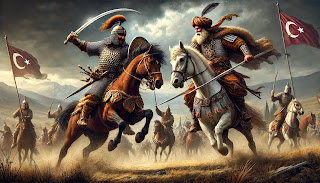By Bobby Darvish, Iranian-American Ex-Muslim, Former Vegan, Former Democrat, Former Socialist, Former CAIR-Columbus Executive Director, Former Muslim Forum of Utah President, Christian Conservative LDS
The history of Central Asia is a tapestry woven with the clashes of ancient peoples. Among these, the battles between the Scythians—an Iranian nomadic people who roamed the Eurasian steppes—and the Turks, a later group of nomadic and semi-nomadic peoples, stand out as formative conflicts that shaped the political, cultural, and military history of the region. This article provides a detailed account of these battles, highlighting their significance and impact.
1. Early Encounters: The Rise of the Scythians and Proto-Turks
The Scythians (8th century BC–3rd century AD) were among the earliest great nomadic civilizations, renowned for their horse archery, mobile warfare, and mastery of the steppe. The Turks (6th century AD onwards), descendants of the Xiongnu and other Altaic-speaking tribes, emerged later as formidable rivals.
While the Scythians predate the Turks by several centuries, the cultural and military practices of these two groups would eventually collide in the tumultuous early medieval period.
2. Battle of Jeti-Su (6th Century AD)
Context: The Göktürks, one of the earliest Turkic empires, expanded westward into the Jeti-Su region (modern-day southeastern Kazakhstan). This region was home to Iranian-descended groups, including remnants of Scythian-aligned Saka tribes.
Key Events:
- The Göktürks sought to dominate the Silk Road trade routes controlled by these Iranian peoples.
- Using their heavy cavalry and disciplined mounted archers, the Göktürks overwhelmed the Saka, who relied on guerrilla tactics and swift cavalry charges.
Outcome: The Göktürks consolidated control over Jeti-Su, absorbing many Iranian elements into their empire.
3. Clash at the Syr Darya (7th Century AD)
Context: As the Turks pushed into the Transoxiana region, they encountered fierce resistance from Iranian descendants of the Scythians, including the Sogdians and Kushano-Hephthalites, who inherited Scythian traditions.
Key Events:
- A coalition of Sogdian and Scythian-descended tribes resisted Turkic incursions.
- Despite being outnumbered, they used their knowledge of the terrain and hit-and-run tactics to inflict significant losses on Turkic forces.
Outcome: The Turks eventually prevailed, but the battle slowed their westward expansion and showcased the resilience of Scythian warfare traditions.
4. The Alani Resistance (8th Century AD)
Context: The Alans, a Scythian-descended people in the Caucasus, faced Turkic pressures from both the Khazars (a Turkic polity) and the emerging Islamic Caliphate.
Key Events:
- The Alans formed a coalition with Byzantine forces against Khazar and Arab incursions.
- Skirmishes were fought across the Caucasus, with the Alans relying on their Scythian-style cavalry.
Outcome: The Alans successfully resisted total domination, preserving their identity despite Turkic and Arab pressures.
5. Battle of Talas (751 AD)
Context: While not a direct Scythian-Turkic clash, the Battle of Talas featured descendants of Scythian peoples (Sogdians) caught between the Abbasid Caliphate and the Turkic Tang Chinese forces.
Key Events:
- The Turkic Karluks, allied with the Abbasids, turned against the Tang Chinese.
- Sogdian elements played a key role, initially supporting the Tang but later retreating.
Outcome: The Turkic victory at Talas allowed Islam to spread into Central Asia, further displacing Scythian-descended groups.
6. Decline of Scythian Influence
By the 10th century, the dominance of Turkic groups like the Seljuks and Ghaznavids overshadowed the remnants of Scythian-descended peoples. However, Scythian cultural elements persisted, influencing Turkic art, warfare, and governance.
7. Legacy of the Scythian-Turkic Clashes
The battles between the Scythians and Turks are more than mere historical footnotes; they reflect a deeper struggle for control over the steppes and trade routes of Central Asia. The Scythians' legacy endured in the form of their contributions to the cultural and military traditions of later Turkic empires.
Conclusion
As an Iranian-American and an ex-Muslim who treasures my Scythian heritage, I view these battles as a testament to the resilience of my ancestors. Their defiance against invading forces, whether Turkic or otherwise, inspires me as I reflect on my journey from Islam to Christianity, from Marxism to conservatism. The spirit of the Scythians lives on in those of us who cherish freedom and identity.
Citations
- Sulimirski, T. (1985). The Scythians. London: Thames & Hudson.
- Golden, P. B. (1992). An Introduction to the History of the Turkic Peoples. Wiesbaden: Otto Harrassowitz.
- Grousset, R. (1970). The Empire of the Steppes: A History of Central Asia. New Brunswick, NJ: Rutgers University Press.
- Bosworth, C. E. (2000). "The Turks in the Islamic Lands." In The Cambridge History of Iran, Volume 4.
- Sinor, D. (1990). The Cambridge History of Early Inner Asia. Cambridge: Cambridge University Press.


No comments:
Post a Comment